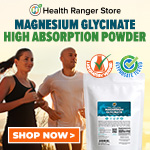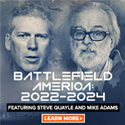
Cancer Drug Ads Put Caveats in Fine Print (press release)
Friday, July 28, 2006 by: NewsTarget
Tags: health news, Natural News, nutrition
- NIH genetic counselor caught on hidden camera advising researchers on how to bypass DOGE oversight
- The hidden war above: Chemtrails, HAARP and the battle for planetary control
- “A Consumer’s Dictionary of Food Additives”: A comprehensive guide to understanding the substances that make their way into your diet
- Florida Senate passes bill banning geoengineering and weather modification and Governor DeSantis has indicated it will become law
- Oil prices plunge as U.S. crude inventories surge and OPEC surprises with output boost
- FSB foils Ukrainian terror plot targeting Russian military cadets, exposes Kiev's covert war against Russia
- Hidden toll: Federal secrecy shields wind industry's eagle deaths to protect land-hungry turbines that yield minimal power
- The revolution begins: HHS mass layoffs are a necessary purge of government bloat
- George Floyd double standard: White 4.0 athlete slaughtered by Black teen-media silent
- Putin launches largest military call-up since 2011 amid escalating tensions
- Chief Justice Roberts faces scrutiny over ties to anti-Trump legal strategist Norm Eisen
- 7 Must-have multi-functional survival tools for every prepper
- “Prepare Tribe: Prepare, Protect, Provide” on BrightU: The Mitchells share tips and tricks to thrive when the grid goes down
- Rice: History, nutrition and how to choose the healthiest varieties
- Global pedophile ring “Kidflix” shut down in landmark Europol operation
- ChatGPT’s cowardly DOUBLE STANDARD: Bowing before Islam while mocking Christianity
- Idaho Gov. Brad Little vetoes Medical Freedom Act
- Science unlocks nature’s potential: How natural compounds may support individuals with Autism Spectrum Disorder (ASD)
- Newly released JFK files reveal Pentagon's role in creating Lyme disease and covid in the same lab
- European Court of Justice: Healthcare professionals who promoted or administered COVID-19 vaccines are CRIMINALLY LIABLE for any harm caused
- Aerosolized bioweapons? Strange “diploid biomasses” falling out of the sky in Florida captured under the microscope
- Oncologist warns of ‘terrifyingly aggressive’ cancers in children, linked to immune suppression from COVID vaccines
- Britain’s descent into police state censorship: Parents raided for questioning their daughter’s school system online
- Analysis: The coming economic collapse, a mass uprising and Trump's three secret weapons to halt the growing revolt
- Utah governor allows ban on LGBT pride flags in public buildings and schools, will take effect without his signature
- Kiss Your Genetic Privacy Good-Bye! 23andMe Gets Green Light to Sell Your Intimate Genetic Details to Anyone They Want
- FBI imposed gag order on agents to silence Hunter Biden laptop truth before 2020 election, new chat logs reveal
- The Health Ranger releases “Vaccine Zombie” song and music video, using AI-animated zombies for the music video
- DARPA: The shadowy innovator behind the world’s most advanced military technologies
- Mike Adams releases country western hit single: Goin’ Back in Time is Comin’ Home
- “Project Aldrin”: Senate probes Meta's alleged censorship dealings with China
- When antibiotics are unavailable, natural ANTIMICROBIAL compounds become essential first line defenses against infection
- AI-powered forecasting model proves more accurate than traditional systems at predicting the weather
- German researchers find link between mRNA vaccines and GENETIC CHANGES that precede CANCER and AUTOIMMUNE DISORDERS
- Dr. Mary Talley Bowden drops bombshells about children being permanently damaged by mRNA jabs during Tucker Carlson interview
- Ancient kitchen secrets REVEALED: How garlic, ginger and green onions fight cancer and heart disease
- Newly released JFK files reveal Pentagon's role in creating Lyme disease and covid in the same lab
- California's social media censorship law struck down: A victory for free speech or a threat to online safety?
- The Health Ranger releases “Vaccine Zombie” song and music video, using AI-animated zombies for the music video
- Dr. Mike Yeadon releases 15-minute testimony - WATCH - about genocidal intent of COVID “vaccines”
- EPA advisor admits the agency is funneling billions to climate groups ahead of Trump’s return to White House
- Rep. Nancy Mace introduces bill to ban biological males from female facilities on federal property
- Florida takes a stand: DeSantis proposes permanent ban on mRNA vaccine mandates
- Sugarcane extract superior to cholesterol-lowering drugs?
- Survival 101: Effective EMF blocking techniques
- Mike Adams releases country western hit single: Goin’ Back in Time is Comin’ Home
- OpenAI whistleblower who dissented against how the company trained ChatGPT found dead
- Attorney and TikTok influencer explains how he was offered hundreds of dollars to make false claims about Trump, Republicans
- CONSERVATIVES SOUND THE ALARM: Big Pharma and the Left trying to force $32 billion money grab from America’s seniors into year-end spending deal
- Pilots report mysterious lights 'moving at extreme speeds' across Oregon skies
- Trump expected to choose Kelly Loeffler as his agriculture secretary even though she was caught INSIDER TRADING during COVID
- Marketing director responsible for WOKE Jaguar rebrand is also an LGBT activist who supports Black Lives Matter
- Unpacking the Lies That We’ve Been Fed – new song and music video released by Mike Adams, the Health Ranger
- Poll: Majority of Ukrainians want peace negotiations to end war with Russia
- Red Cross issues warning to stop blood plasma donations from vaccinated people
- Scientists confirm: GENIUS brain function can be spontaneously unleashed in humans without any apparent cause
- EPA advisor admits the agency is funneling billions to climate groups ahead of Trump’s return to White House
- HYSSOP: What research reveals about the health benefits of this ancient holy herb
- Two containers with completed ballots fall out of truck in Florida
- Fully vaccinated about to see “tsunami” of illness and death, warns virologist
- Global leaders unite to clamp down on “misinformation” with UN-backed Cascais Declaration
- BREAKING: 2025 NDAA authorizes mandatory military draft of WOMEN across America… as Pentagon pursues global NUCLEAR war with both Russia and China at the same time
- Newly released JFK files reveal Pentagon's role in creating Lyme disease and covid in the same lab
- Michael Yon warns of a ZIONIST TAKEOVER in Trump’s second administration
- BOMBSHELL: DNA testing kits are a SCAM to develop ethnic-specific bioweapons
- Ozempic and Wegovy weight loss drugs are injectable LIZARD VENOM PEPTIDES that may unleash a devastating wave of organ failure… side effects align with symptoms of SNAKE BITES
- The Health Ranger releases “Vaccine Zombie” song and music video, using AI-animated zombies for the music video
- Israeli soldiers accused of even more torture and abuse in the West Bank
- These 13 countries just signed an agreement to engineer a global FAMINE by destroying food supply
- NASA admits that climate change occurs because of changes in Earth’s solar orbit, and NOT because of SUVs and fossil fuels
- RFK Jr. clears key hurdle: Sen. Susan Collins backs controversial HHS nominee, signaling a new era for health policy
- Sermon 30: How Jesus reveals Caesar’s FAKE CURRENCY and FALSE AUTHORITY
Drugs to fight cancer that were advertised in consumer-based magazines seemed to promote all of the benefits of the drugs in large text. Risks and side effects, however, generally appeared lower on the page and in a smaller, more difficult-to-read text.
"Direct-to-consumer advertising of oncology medications typically focuses on the drugs' benefits, as would be expected, but it does so in a manner that might lead some cancer patients to not appreciate equally the drugs' potential side effects and risks," study author Dr. Gregory Abel, of the Dana-Farber Cancer Institute in Boston, said in a prepared statement. "Oncology providers should be aware of these advertisement characteristics, as they may influence patients' perceptions of and requests for these medications."
Researchers studied ads in 2005 issues of three magazines geared toward patients -- CURE, Coping with Cancer and MAMM. Ads were reviewed for readability using the Flesch Reading Ease measurement guide. The study examined the size and content of the text, placement of text, clinical data, patient testimonials and pictures of patients. Researchers also noted any physician or celebrity endorsements, information on effectiveness, and safety information.
Overall, text relating to benefits of the drug tested the easiest to read and tended to appear in the top third of the ad space. Benefit text was also typically written in a larger size.
Explanation of risks and side effects were typically in a small-size text at the bottom third of the ad space, but the length of the text for both sections was approximately equal. Approximately 80 percent of the ads contained patient images, and 67 percent contained clinical data. Physician or celebrity endorsements were not used in any of the ads.
Results of the study were presented this week at the American Society of Clinical Oncology's annual meeting, in Atlanta.
"We found that appeals to medication safety are infrequent in oncology print direct-to-consumer advertisements, while appeals to medication effectiveness are ubiquitous and often made through the presentation of clinical trial data," Abel said. "Such appeals to the scientific efficacy of cancer-related medicines, while suitable in the setting of clinical encounters, may not be appropriate when made directly to consumers via language that is difficult to read."
Health news at FETCH.news
Get independent news alerts on natural cures, food lab tests, cannabis medicine, science, robotics, drones, privacy and more.
Take Action: Support Natural News by linking to this article from your website
Permalink to this article:
Embed article link: (copy HTML code below):
Reprinting this article:
Non-commercial use OK, cite NaturalNews.com with clickable link.
Follow Natural News on Facebook, Twitter, Google Plus, and Pinterest
Science News & Studies
Medicine News and Information
Food News & Studies
Health News & Studies
Herbs News & Information
Pollution News & Studies
Cancer News & Studies
Climate News & Studies
Survival News & Information
Gear News & Information
News covering technology, stocks, hackers, and more



"Big Tech and mainstream media are constantly trying to silence the independent voices that dare to bring you the truth about toxic food ingredients, dangerous medications and the failed, fraudulent science of the profit-driven medical establishment.
Email is one of the best ways to make sure you stay informed, without the censorship of the tech giants (Google, Apple, Facebook, Twitter, YouTube, etc.). Stay informed and you'll even likely learn information that may help save your own life."
–The Health Ranger, Mike Adams













































